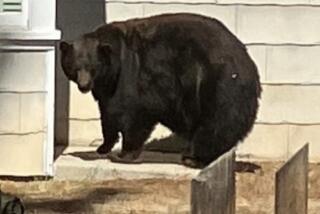Sled Accidents Pile Up in Record Snows
- Share via
BOSTON — In Larz Anderson Park in Brookline, Mass., a 4-by-5-foot sign warns: “Use Hill at Your Own Risk.” On a brilliant Friday, 6-year-old Daniel Fairnet was ready to heed that warning.
He gazed at the snow-coated slope and pointed at a tree halfway down.
“Dad, Dad, I’m not taking a chance on hitting that tree,” he said.
“We’re not going to hit that tree. Quit worrying about it and get on,” Greg Fairnet said. Then he and his son slid downhill on a blue plastic sled Fairnet bought 15 years ago. They made it safely to the bottom.
In a year of unusually heavy snow, Daniel appears to be showing far more restraint than other sledders.
Medical experts say they’re facing an epidemic of sledding injuries this year, as cemeteries, golf courses--even stairwells and stadiums--glisten temptingly in a coat of white.
During one recent week, Children’s Hospital in Boston treated 22 children for sledding injuries. Ten were hospitalized, five in intensive care. Children’s Hospital of Pittsburgh recently treated eight serious sledding injuries in a nine-day period. Philadelphia Children’s Hospital treated seven.
The hospitals don’t keep lists of sledding injuries from year to year, but doctors think this season is definitely off to a worse start than usual.
“One child went through ice on a pond and drowned. We’ve seen some major trauma, some facial fractures,” said Dr. Gary Fleisher, chief of emergency medicine at Boston Children’s Hospital.
In Ohio, four women broke their backs in separate sledding accidents on “Suicide Hill” at Community Golf Course in Kettering the week before Christmas. Miami Valley Hospital treated all four, along with four other people who came in with back injuries from the hill, Dr. Mark Eilers said.
“They come zinging down this hill and go airborne,” he said, “and land at various angles.” Because of the injuries over the years, “the city’s actually gone out and bulldozed the hill down,” Eilers said. “I don’t know why it’s back.”
The hospital has seen a “constant parade” of serious and minor injuries from collisions as well. “You’ve got no air bags on those things,” he said.
From the Northeast to the Great Lakes, it has been an unusually snowy winter--even before this month’s mammoth storm buried the East Coast. Boston sees an average yearly snowfall of 43 inches. Nearly that much had fallen by early this month.
More snow than usual means more sledders, Eilers said, and that means more recklessness. “You get this prowess,” he said. “‘I can go faster than you. I can go backwards. I can go standing up.”’
Fleisher said trouble also comes from the current fashion in sledding: inflatable snow tubes. The round, pillow-like tubes will bounce over just about anything but are difficult to control.
“I think all of us who work in the emergency department have a sense that the greater number of injuries are related to the inflatable tubes,” Fleisher said.
Adding to the problem, some say, is that children don’t always choose the relative safety of an open hill.
“Children tend to pick any hillside that is steep enough for them to gain momentum,” said James Lynch, director of the Benedum Pediatric Trauma Program in Pittsburgh. Urban children who don’t have parks will sometimes make the most of what they have.
In East Providence, R.I., David Kelleher, principal at Silver Spring Elementary School, has trouble keeping a concrete set of steps clear of snow. “We clean them and [sledders] come in and shovel snow back on the stairs and scoot down them,” he said.
A metal handrail keeps them from going off course but also endangers those who lose control. The children come while the school is closed, so it’s difficult to stop them.
The Consumer Product Safety Commission estimates that 33,000 people a year in the United States, more than half of them younger than 16, require emergency room treatment because of sledding accidents.
Related story: A18
More to Read
Sign up for Essential California
The most important California stories and recommendations in your inbox every morning.
You may occasionally receive promotional content from the Los Angeles Times.












